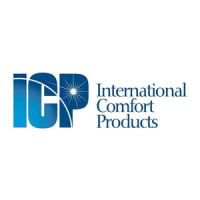
Do you have a question about the ICP PHF330000K00A1 and is the answer not in the manual?
Specifies minimum distances to prevent fire hazards from combustible materials.
Discusses the location and view of access panels for the unit.
Details required air circulation clearances for optimal unit operation and safety.
Instructions on ensuring the unit is installed level, side-to-side, and front-to-rear.
Requirements for platforms and pads for ground-level unit placement.
Platform requirements and structural considerations for roof-mounted installations.
Guidelines for safely lifting and moving the unit using slings and spreader bars.
Steps to convert the unit for downflow airflow applications.
Instructions for installing a condensate trap to ensure proper drainage.
Requirements for a field-supplied, waterproof disconnect switch for unit safety.
Procedures for ensuring a permanent and safe electrical ground connection for the unit.
Details on connecting high-voltage power leads to the unit's control box.
Guidance on thermostat wiring, including single and two-stage configurations.
Explanation of how to adjust the heat anticipator for optimal heating performance.
Recommendations for sizing ductwork to ensure proper airflow and system efficiency.
Requirements for insulating outdoor ductwork with fiberglass and a vapor barrier.
Guidelines for sealing ductwork connections to the unit casing to prevent air leaks.
Importance of filters and recommended sizes for disposable and washable types.
Table and explanation of blower speed tap settings for rated and high airflow.
Wiring instructions for selecting blower motor speeds for heating and cooling.
Pre-start checks including wiring, filters, access panels, and initial power-up sequence.
Describes the cooling cycle operation for 2 to 3.5 ton models.
Details the two-stage cooling cycle operation for 4-ton models.
Describes the heating cycle operation for 2 to 3.5 ton models.
Details the two-stage heating cycle operation for 4-ton models.
Explains the compressor delay timer function to prevent reverse rotation.
How continuous fan operation is handled based on unit size and thermostat settings.
Explanation of the defrost cycle initiation, timing, and operation sequence.
Monthly tasks including checking air filters, condenser coil, and condensate drain.
Monthly checks for the cooling season, focusing on condenser coil and condensate drain.
Annual tasks including cleaning coils, checking fan motors, and blower assemblies.
Guidelines for safely rigging and lifting the unit, including panel placement and spreader bars.
Schematic illustrating electrical connections for 2 to 3.5 ton models.
Schematic illustrating electrical connections for 4 ton models.
